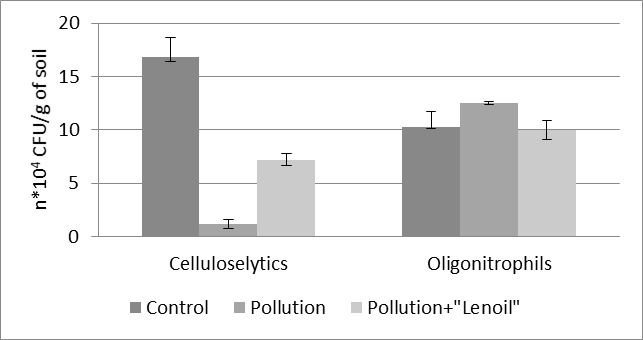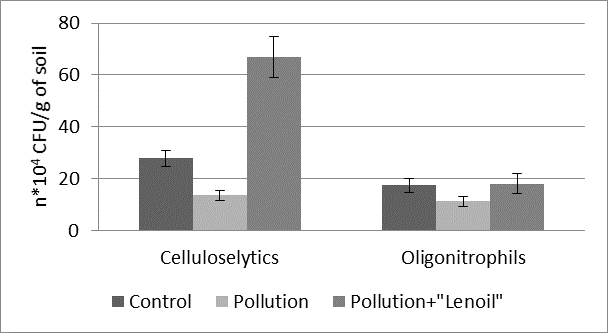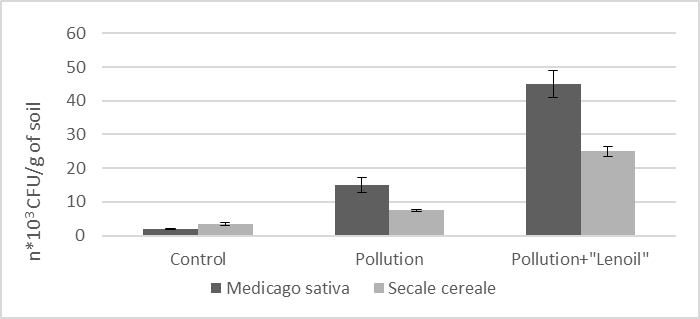AN ASSESSMENT OF MICROBIOLOGICAL ACTIVITY IN THE ROOT ZONE OF MEDICAGO SATIVA L. AND SECALE CEREALE L. PHYTOREMEDIANT PLANTS UNDER THE INFLUENCE OF OIL POLLUTION ON THE SOIL AND AFTER TREATMENT WITH HYDROCARBON-OXIDIZING BIOPRODUCT
AN ASSESSMENT OF MICROBIOLOGICAL ACTIVITY IN THE ROOT ZONE OF MEDICAGO SATIVA L. AND SECALE CEREALE L. PHYTOREMEDIANT PLANTS UNDER THE INFLUENCE OF OIL POLLUTION ON THE SOIL AND AFTER TREATMENT WITH HYDROCARBON-OXIDIZING BIOPRODUCT
Abstract
For remediation and restoration of fertility of oil-contaminated soil it is promising to use complex methods including preparations that include hydrocarbon-oxidizing microorganisms and plants-phytoremediants, in the root zone of which microorganisms actively grow and participate in the degradation of oil hydrocarbons. Thus, the assessment of microbiological activity can characterize the intensity of the processes of cleaning the soil contaminated with oil. The article presents the characteristics of the microbiological biota in the rhizosphere of phytoremediant plants Medicago sativa L. and Secale cereale L. under the influence of oil pollution and after the introduction of the hydrocarbon-oxidizing biopreparation "Lenoil" into the soil. It was shown that the rhizosphere of microorganisms of alfalfa developed more intensively than in the rhizosphere of rye. The use of "Lenoil" stimulated the growth of the number of oil-degrading microorganisms as well as cellulolytic and heterotrophic bacteria and microscopic fungi in the root zone of Medicago sativa L. and Secale segeale L.
1. Introduction
Biological methods for the remediation of oil-contaminated soils currently occupy a large share of all the activities carried out. Biobjects used for soil remediation include hydrocarbon-oxidizing microorganisms and plants-phytoremediants, which can grow in the presence of petroleum hydrocarbons in the soil , , . Bacteria destroy petroleum hydrocarbons by activating enzyme systems and are the leading link in the process of destruction and detoxification of xenobiotics. The mechanisms that occur in the plant organism under conditions of pollution are more complex and diverse. These include accumulation, extraction, stabilization, rhizodegradation , , . To enhance the effectiveness of measures to clean up and restore soil fertility, it is promising to use complex methods, including both specialized preparations and plants-phytoremediants, in the root zone of which microorganisms actively develop due to biologically active root secretions and also take part in the destruction/detoxication of petroleum hydrocarbons. Thus, the aim of the study was to evaluate the effect of the hydrocarbon-oxidizing biopreparation "Lenoil" on the microbiological activity in the root zone of plants-phytoremediants Medicago sativa L. and Secale сereale L. under the influence of oil pollution.
2. Research methods and principles
In the experiment, we used gray forest soil selected in the Ufa region of the Republic of Bashkortostan. Soil samples were incubated in individual vessels with drainage. It was contaminated with commercial oil at a concentration of 4% by weight. After three days, the biopreparation "Lenoil" was introduced as an active destructor of oil hydrocarbons at the rate of 0.3 ml per 100 g of soil. The composition of the biopreparation "Lenoil" – NORD, SHP (manufacturer CJSC SPE «Вiomedchem» technical condition 9291-007-33822935-2014) includes the bacteria Pseudomonas turukhanskensis IB 1.1 (titer not less than 1*108 CFU/g). The biopreparation is intended for biological treatment of oil-contaminated soils and restoration of the productivity of reclaimed soils , .
In the course of preliminary studies, we found that the most resistant to 4% oil contamination of soil among cereal crops was rye (Secale cereale L.) variety "Tatiana", and among representatives of legume family, alfalfa (Medicago sativa L.) variety "Nadezhda" .
Seeds of alfalfa and rye plants were sterilized in chlorine solution and germinated for a day in thermostat at 37 °C, then they were sown into vegetative vessels according to seeding rates 30 days after treatment of contaminated soil with "Lenoil". The vessels were placed on a light platform at a 12-hour light day at a temperature of 22–25 °C. Plants were watered every other day. For further studies, 30-day-old plants were used. Plants grown on uncontaminated soil were used as control.
Soil samples of the rhizosphere were obtained by shaking off adhering particles from plant roots and then scraped off with a sterile scalpel under sterility conditions . To determine the microbiological activity of the soil, the indicators of the number of microorganisms of different ecological and physiological groups were used. Cultivation of heterotrophic bacteria, cellulolytic microorganisms, oligonitrophils, microscopic fungi, and hydrocarbon-oxidizing microorganisms (HOM) was carried out on nutrient media of MPA, Getchinson, Ashby, Chapek, and Dianov-Voroshilova, respectively .
The results were processed and diagrams were constructed using a licensed Excel software package (MS Office 2010). The arithmetic mean, the error of the arithmetic mean, and the confidence interval were calculated. To identify significant differences between the compared indicators, Student's t-test was used at a significance level of p <0.05.
3. Main results
The use of microbial preparations for the remediation of oil-contaminated soil certainly affects the quantitative composition of the native microbiota, including in the rhizosphere of phytoremediant plants . However, the number of microbiota in the rhizosphere depends on the type of plant and the soil on which they are grown. The most general indicator describing soil microbiocenosis is the value of the total microbial number. This indicator corresponds to the number of heterotrophic bacteria grown on a general-purpose nutrient medium. Under the influence of oil pollution, this index decreased by 63% in the rhizosphere of rye plants (Table 1). This happened, probably, as a result of the direct toxic effect of petroleum hydrocarbons. Not enough time has passed since the moment of pollution for a natural decrease in the concentration of the pollutant to occur and, accordingly, the negative impact to decrease. However, in the alfalfa rhizosphere, a slight stimulation of the development of heterotrophic bacteria was noted, indicator increased from 6,7*106 to 10,5*106 CFU/g of soil. A number of authors have already noted a similar phenomenon and explained by the fact that petroleum hydrocarbons in small concentrations can be used as a source of carbon , , , . The total microbial number in the contaminated soil after the introduction of the biological product increased by an order of magnitude compared to the samples that were not treated in the experiment using rye plants as a phytoremediant and amounted to 34,5*106 CFU/g of soil compared to 8,7*106 CFU/g of soil isolated in the control. An even greater increase in the indicator was registered in the rhizosphere of alfalfa plants, which exceeded the control values by 6 times. (Table 1). The observed changes in the number of heterotrophic bacteria under the influence of a biological product may be due to the fact that the hydrocarbon-oxidizing microorganisms that make up its composition not only reduce the concentration of pollutants, but also destroy complex oil hydrocarbons and make them available for other bacteria to feed on. In general, a more favorable environment for the growth of bacteria developed in the rhizosphere of Medicago sativa L. plants, and the presence of microorganisms of the biological preparation additionally contributed to this process .
Table 1 - Numbers of heterotrophic bacteria and microscopic fungi in the rhizosphere of plants Medicago sativa L. and Secale cereale L. under the influence of soil oil pollution and application of "Lenoil"
Indicator | Control | Pollution | Pollution + "Lenoil" | |||
1 | 2 | 1 | 2 | 1 | 2 | |
Heterotrophic bacteria (n*106 CFU/g of soil) | 6,7±1,18 | 8,7 ±1,04 | 10,5±1,94 | 3,25±0,29 | 41±5,74 | 34,5±3,18 |
Microscopic fungi (n*103 propagol/g of soil) | 10,75±1,85 | 1,1±0,07 | 20±3,2 | 22,25±2,0 | 29±3,19 | 46,75±3,9 |
Note: 1 – Medicago sativa L.; 2 – Secale cereale L.
As a result of the analysis of the study data, an increase in the number of microscopic fungi in samples of contaminated and reclaimed soil was noted. In the presence of oil in the rye rhizosphere, the number of micromycetes increased by 22 times compared to the control, and after the introduction of the biological preparation, it increased by 2 times (Table 1). The situation is logical because many microscopic fungi are resistant to the action of this pollutant and can also take part in its degradation , , , .
The intensity of the development of microscopic fungi in the rhizosphere of alfalfa was significantly lower, as compared with the control values, the number of micromycetes increased by 2 times under the influence of oil pollution and by about 3 times after the introduction of the preparation «Lenoil». However, it should be noted that the initial level of rhizosphere infestation by microcycetes differed significantly: in the root zone of rye (1,1 propagols in 1 g of soil), there were about 10 times fewer fungi in the control than in alfalfa (10,75 propagols in 1 g of soil). Despite the differences in clean soil, the number of micromycetes in contaminated soil was the same in rye (20 propagol/g of soil) and alfalfa (22,25 propagol/g of soil) samples.
In the composition of the root microbiota, the permanently present microorganisms include representatives of oligonitrophils and cellulosolytics. Figure 1 shows that the number of cellulosolytics in the rhizosphere of rye significantly decreased under the influence of oil pollution of the rye rhizosphere from 16,8*104 CFU/g (clean soil) to 1,2*104 CFU/g, because this group of microorganisms is highly sensitive to the pollutant, which has been repeatedly shown , , . Addition of hydrocarbon-oxidizing bacteria of "Lenoil" had a favorable effect on their numbers, but the toxic effect of oil was not completely eliminated, and their numbers did not recover to the control values. A similar trend in the number of cellulose-destroying microorganisms was observed in the rhizosphere of alfalfa (Figure 2), but in this experimental variant the indicator was 2.4 times higher than the control values after treatment with the biopreparation and amounted to 66,9 *104 CFU/g of soil compared to 27,8*104 CFU/g of soil isolated in the control.

Figure 1 - The number of cellulosolytic and oligonitrophilic microorganisms in the rhizosphere of plants Secale cereale L. under the influence of oil pollution and bioremediation with the preparation "Lenoil"

Figure 2 - The number of cellulosolytic and oligonitrophilic microorganisms in the rhizosphere of plants Medicago sativa L. under the influence of oil pollution and bioremediation with the preparation "Lenoil"

Figure 3 - The number of hydrocarbon-oxidizing microorganisms in the rhizosphere of plants Medicago sativa L. under the influence of oil pollution and biopreparation "Lenoil"
4. Conclusion
Thus, microorganisms of different ecological groups developed better in the root zone of Medicago sativa L. plants, than in Secale cereale L. plants. This may be due to the specifics of basal secretions characteristic of species of different families and classes. The use of the preparation "Lenoil" for the treatment of oil-contaminated soil and plants-phytoremediants stimulated the growth of the number of oil-degrading microorganisms (45*103 CFU/g of soil in the rhizosphere of alfalfa and 25*103 CFU/g of soil in the rhizosphere of rye) and contributed to the normalization of other characteristics of microbial community in the rhizosphere of plants from the families Poaceae and Fabaceae.
